So, how are you guys? Now it's time to stretch the last topic of space and discover some deeper mysteries of space through some simple questions.
In the last post you learnt that space is not like what we had imagined. It’s not just a static infinite void. It actually exists and have some fantastic physical properties. And today we are going to discuss some other questions related to its physics: Does space have an overall shape? If it is like other physical things, is it also quantized like other thing in the universe? Let’s try to answer these seemingly simple questions.
So, let’s begin!
Does Space Have Any Overall Shape?

Hi Space | Freepik
If you are not yet impressed by the mind-bending concepts of stretching and bending of space, here’s another mystery for you: Is space flat or curved? If it is curved, then which way does it curve?
These crazy questions are not far-fetched if we accept the notion that space is malleable. If space can bend around objects with mass, then it is possible for it to have an overall curvature? It is like asking if our space-goo is flat or it has any shape.
Answering these questions about space would also affect our understanding of the universe. For example, if space is flat, it means if you start travelling in one direction you’ll keep going possibly to infinity.
But, if space is curved, then other interesting things might happen. If space has an overall positive curvature, then going off in one direction might actually bring you to the point from where you started. This will really be a fun.
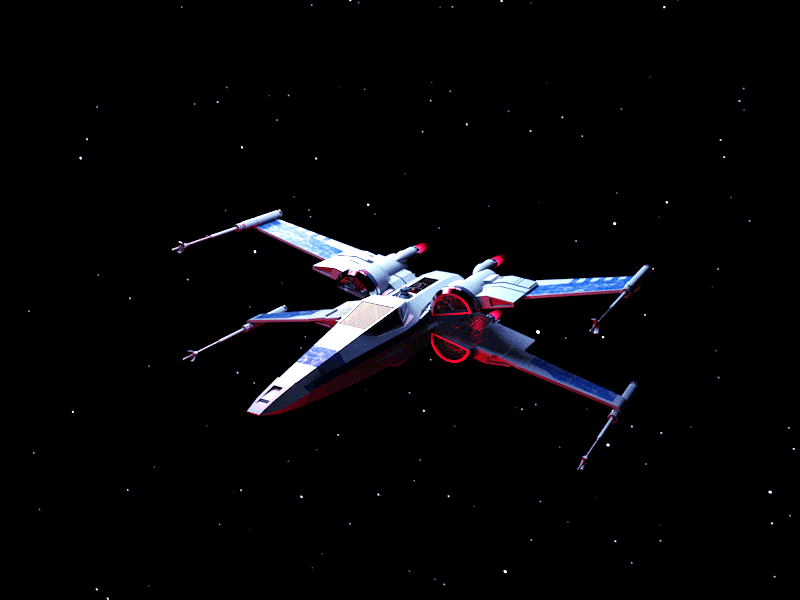
Spacecraft looping in Curved Universe
But explaining idea of curved space is not easy because our brains are not well equipped to visualize the concept. We live in a three-dimensional world that seems pretty much fixed and our everyday life is connected only with that. But if some advanced extraterrestrials with ability to manipulate the curvature of space invade us, then the scenario will be different. I hope, we too will figure that out soon.
It’s really difficult to imagine our three-dimensional space to have a curvature. But we can visualize it, if we imagine that we live in a two dimensional world (like being trapped on a sheet of paper). In that situation we don’t have any z-axis, means there will be no above and below.
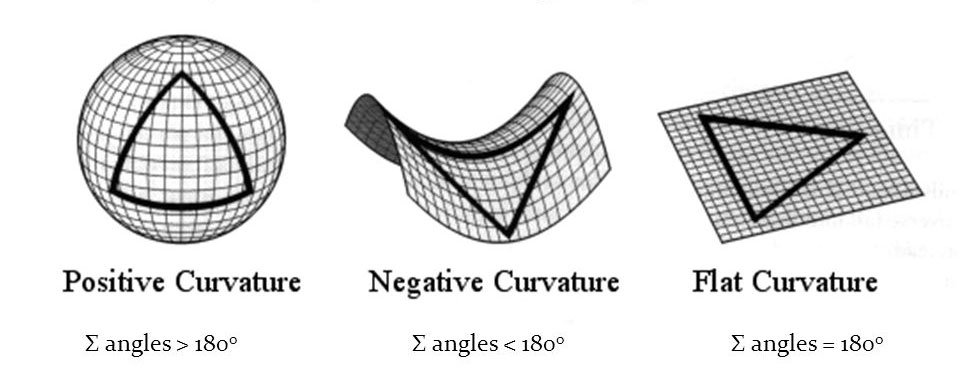
Possible Curvatures of Space
And now, if the sheet of paper lies straight we say our space is flat. But for some reason if the sheet of paper is bent, then we say that the space is curved. And there are two ways in which paper can be bent. If it is curved in one way like the surface of a sphere, it is called positive curvature. And if it is curved the other way like the surface of a horse saddle, then it is called negative curvature.
Now here is the interesting part: if it turns out that space is flat everywhere, it means that the sheet of paper (space) could potentially go on forever. But if we find that space has an overall positive curvature, then only one shape we can imagine of: a 'sphere' or to be more specific a ‘spheroid’ (i.e. a potato). If this happens to be true, then our universe will loop around itself. We could be living in a three dimensional equivalent of a potato, which means doesn’t matter in which direction we go, will end up coming back to the same spot.
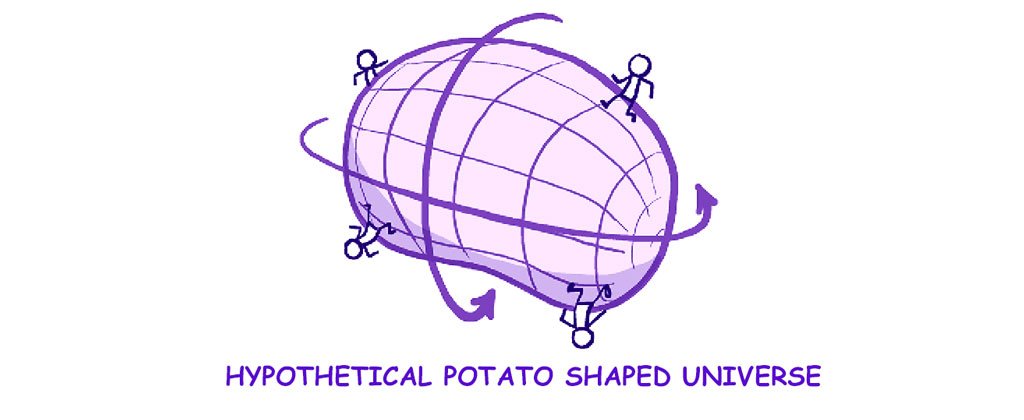
Potato Universe 😀
So, which one is our space like? Is it flat? Or does it have a shape of a potato or a horse saddle?
Well, in this case we have an answer. Our space does appear to be pretty much ‘flat’ with a minimal error of 0.4%. Scientists through two different methods have calculated that, the curvature of space, at least the space we can observe, is very near to zero.
But what are these two ways to calculate the curvature of space? One of the ways is by measuring triangles. One interesting fact about curvature is that, triangles on curved surface don’t follow the same rules as on flat surface. [i.e. on flat surface, the sum of all three interior angles of a triangle = 180°, but on curved surface it is either greater than 180° or less than 180°]
Scientists have carried out the equivalent of measuring the triangles drawn in our three-dimensional universe by looking at the picture of early universe with the help of Cosmic Microwave Background Radiation (CMBR) and calculated the special relationships between different points on that picture. They found something equivalent to the sum of angles of triangle equals to 180°, which corresponds to a flat space. [1]
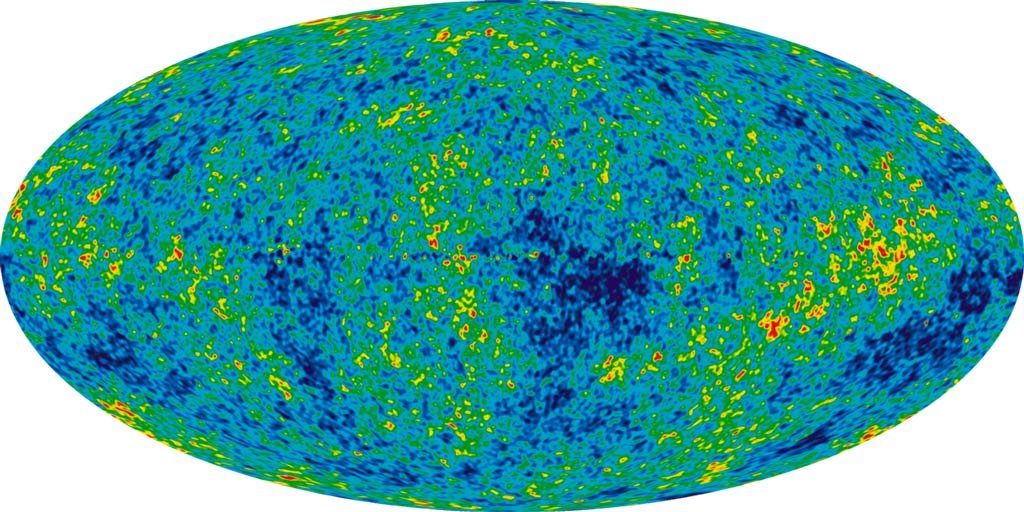
Image of Infant Universe by WMAP observations | Wikipedia
The other way through which we can tell about the curvature of space is by looking at the thing that causes it in the first place: the energy in the universe. According to general relativity, there is a specific density of energy in the universe that can cause space to bend in one direction or the other. Measurements from the Wilkinson Microwave Anisotropy Probe (WMAP) have shown that the observable universe has an energy density very close to the critical density (with a 0.4% of error) causing space to be pretty much flat. [1]
Some of you might be disappointed by the fact that we don’t leave in a cool three-dimensional cosmic potato. But you should be more intrigued than disappointed. Why? Because, as far as we know that this flat universe we are living in is basically a gigantic cosmic level coincidence.
We should think about the fact that all the mass and energy is what that give space its curvature and we have just the right amount of them to make the space flat. To be more specific the exact amount for the universe to be flat is about five hydrogen atoms per cubic meter of space. If we had six hydrogen atoms per cubic meter of space, then it would have curved in one way and if we had four hydrogen atoms per cubic meter then it would have curved the other way.
But again, for space to be pretty flat now means it had to be extremely flat in the early phase of the universe or there has to be something else keeping it flat. This is one of the greatest mysteries about space.
What is the size of the Space?
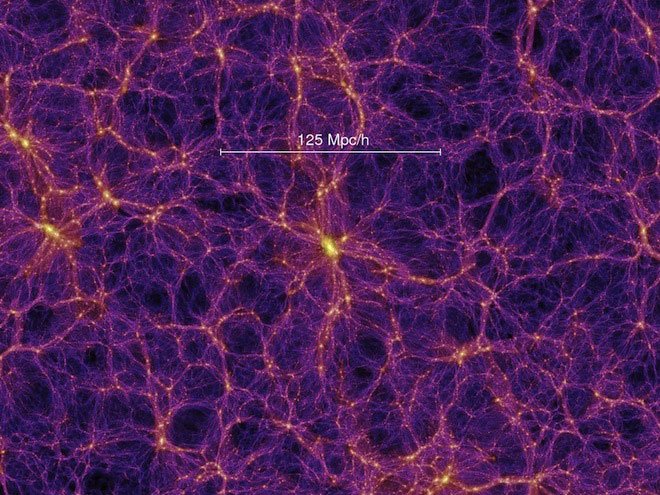
Superclusters – Do they have any edge | Wired
The curvature of space is not the only thing we have questions about when it comes to the nature of space. When we accept the fact that space is not an infinite void, it opens up many strange questions like, what is the size and shape of space?
If space would have been curved and had a shape of a potato, then it would have been finite in size. But we know that space is flat and it means that it must go on forever, right? Not necessarily!
Space can be flat yet have an edge to it or even stranger it could be flat and still loop around itself.
How can space have an edge? Actually, there is no reason why it can’t have. It can still have a boundary even if it is flat. For example, a disc is flat two-dimensional surface with smooth continuous is edge. Perhaps, three dimensional space may also have a boundary at some point with some strange geometrical properties.

Edge Looping Snake Game | Giphy
Even more astonishing is that it is possible for space to be flat with edge and still loop around itself. It would be like one of those video games like Pac-Man, where if you move beyond one edge of the screen you simply appear on the opposite edge.
Space might be able to connect with itself in some mysterious way that we are not completely aware of. For example, ‘wormholes’, which are predicted by general relativity, can connect two different points in space that are farther apart. What if the edges of the universe are also connected in a similar way? We don’t know.
Is Space Quantized?
Is Space Pixelated?
Finally, you may also ask whether space is made up of tiny discrete bits of space, just like the pixels on a TV screen. Or is the space infinitely smooth, such that we can have infinite number of places between two points.
In ancient times, scientists or philosophers might not have imagined that air can be made up of tiny discrete molecules. After all, it appears to be smooth and continuous when it blows. It also can fill any volume and has interesting dynamical properties like wind and tornados. Yet we now know that these all are actually combined behaviour of billions of individual air molecules and not the fundamental properties of the individual air molecules.
The smooth continuous space concept may appear to make more sense to us. Because this is what our experience about space tells us. We easily glide through space and don’t jump from pixel to pixel in a jerky fashion like a video game character. Or do we?
But, according to our current understanding of the universe, it will be more surprising if space turns out to be infinitely smooth. This is because, everything else we know in the universe is quantized. Matter is quantized, energy is quantized, forces are quantized and even time is quantized. Moreover, quantum mechanics suggests that we cannot have any length smaller than 10-35 m (Planck Length). So from quantum mechanics perspective, it will make more sense if space was quantized, but again we have no idea.
But having no idea hasn’t stopped physicists from imagining crazy possibilities about quantum space. If space is quantized, then it means that when we move across space we are actually jumping from small little locations to other small little locations. In that view, space is a network of connected nodes, like the stations in a subway system. Each node represents a location in space and the connection between nodes represents the relationship between those locations (which one is next or before to which one). This idea is, however, different from the philosophy that space is just a relationship between matter, because these nodes of space can be empty and still exist.
In that scenario, what we call space can be just a network of those connected nodes and all the particle in the universe would just be the property of this space rather than elements in it. For example, they might be some vibrational mode of these nodes.
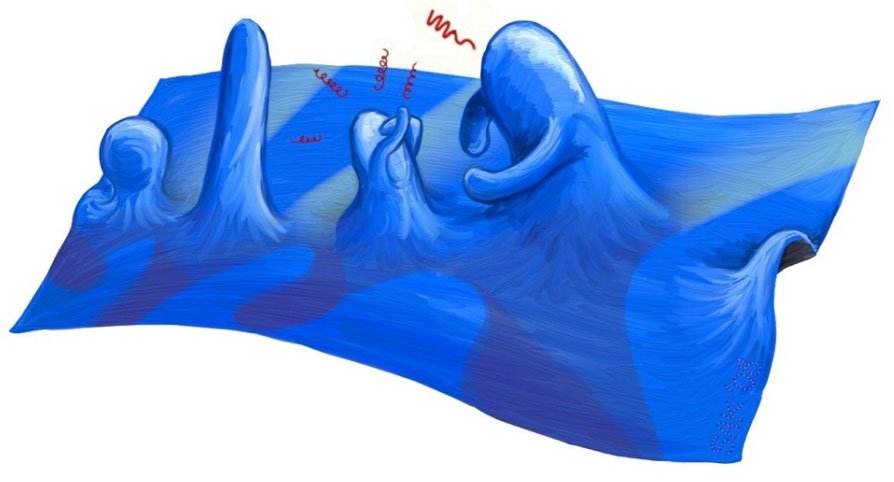
Illustration of Quantum Fields
Yeah, this is possible. The current theory of particles is based on quantum fields that fill all the space. A field is just a number or value associated with every point in space. According to this theory, particles of matter are just the excited states of these fields. [2] So, we are not too far from the amazing theories already.
Conclusion
The more we try to know about space the more we get surrounded by puzzling questions. The revelations of the weird properties of space have made the thing more complicated. But there are no bounds to imagination.
Yet, there are many crazy things which we can think of if we take space like a physical thing with amazing physical properties. For example, if space is like air, it is possible for it to have different states and phases. Under extreme conditions, maybe it can arrange itself in very unexpected way and have weird unimaginable properties, just like air behaves when it is solid, liquid or gas. Maybe there are different types of space out there in the universe just waiting for us to discovered them.
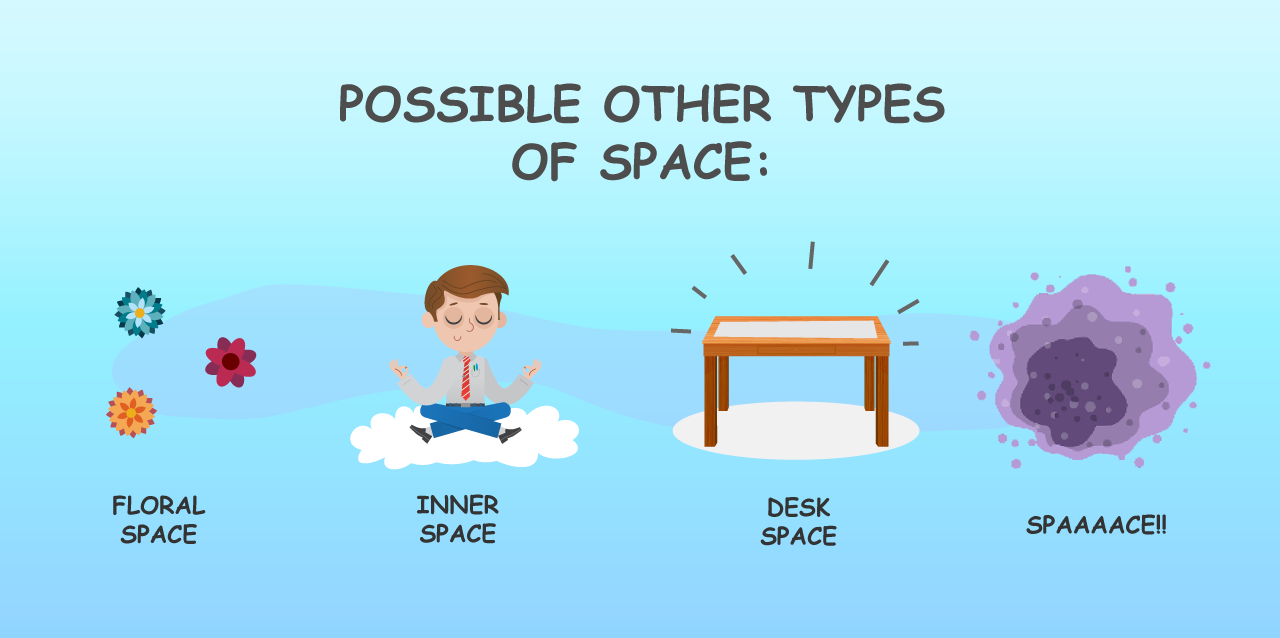
Different types of Space
Maybe we can actually understand the weird properties of space if we observe it in extreme conditions where it is distorted by mass and energy. We can find such conditions by looking carefully at places where cosmically huge masses are squeezing and straining it: black holes. If we explore near black-holes we might see space shredded and chopped making us capable to observe and examine it from inside.
Perhaps, we are pretty much near to unveil the mysteries of space. Now we have advanced technology to observe the space minutely. We have already observed the curvature and ripples of space. Maybe we are very much near to the answers but unable to locate them.
So don’t go anywhere before upvoting and resteeming this post. And yes, save some space in your brain for the answers.
So, what's your thinking about space? Have you got any new idea about time which can help our physicists, who are breaking their heads for this spacey question?
Do let us know through your comments. ;)
- Source : http://thinknitesh.com/what-is-space/ (an excerpt from my blog)
I will be very much happy if you UPVOTE and RESTEEM this post.
This will help me to buy more material for next posts and provide me the worth of my hardwork.
References
[1] – https://en.wikipedia.org/wiki/Shape_of_the_universe
[2] – https://en.wikipedia.org/wiki/Quantum_field_theory
[•] - Jorge Cham and Daniel Whiteson (2017) : We Have No Idea
Previous Episodes of the Series
- Simple Question #1 - Why do we Dream? What is its purpose?
- Simple Question #2 - What is Life? Why does it exist at all?
- Simple Question #3 - How big is the Universe? What is its Shape?
- Simple Question #4 - Should we eat Meat? Why and Why Not?
- Simple Question #5 - What is Time? Will it ever stop or reverse?
- Simple Question #6 - Do we all feel Time the same way? Can we travel back in Time?
- Simple Question #7 - What is Space? Is It Really a Static Infinite Void?
Follow me @nitesh9



--- thinknitesh.com ---
